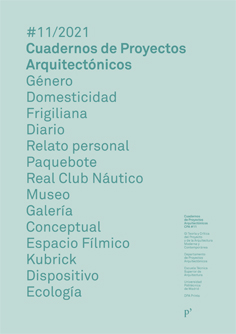El espacio fílmico del Hotel Overlook en The Shining a través de sus decorados
DOI:
https://doi.org/10.20868/cpa.2021.11.4827Palabras clave:
Arquitectura, Cine, Kubrick, El Resplandor, Espacio Fílmico, Architecture, Film, The Shining, Filmic SpaceResumen
Resumen
Para la construcción del Hotel Overlook (The Shining ,1980), Stanley Kubrick recurre a la reproducción de réplicas a escala 1:1 en los estudios Elstree de Londres de diferentes fragmentos de hoteles, moteles y resorts de vacaciones esparcidos por Estados Unidos. Mediante un trabajo minucioso de observación de fotografías y elaboración de maquetas se construyen unos decorados de los diferentes ámbitos que conforman el hotel. Kubrick compone una arquitectura que surge de un cuerpo fragmentario, construido y ensamblado que, mediante las posibilidades narrativas que ofrecen la steadicam y el montaje cinematográfico, se transforma en un espacio fílmico aparentemente unitario. El hotel se muestra como una arquitectura verosímil que, sin embargo, está repleta de paradojas, de referencias externas, de subtextos y de imposibilidades espaciales, pues al observar detenidamente la película se encuentran múltiples puntos que subvierten la lógica del espacio. A través de maquetas, fotografías y entrevistas, y su confrontación con la película, se elaboran planos de los diferentes ámbitos del Overlook con el objetivo de abrir un campo de reflexión sobre la intención de su posible ensamblaje. También sobre la relación que existe entre la estructura narrativa de la película, basada en tiempos y espacios que se entrelazan y la manera en que los decorados se unen entre sí, en la pantalla. Mediante un análisis basado en la expresión arquitectónica, el artículo estudia algunas de estas incongruencias espaciales para especular sobre una posible interpretación de la película en la que la arquitectura juega un papel nuclear desde su concepción, no sólo por la importancia de sus decorados en el desarrollo, sino también a un nivel iconográfico y narrativo.
Abstract
For the construction of the Overlook Hotel (The Shining, 1980) Stanley Kubrick recreates, at Elstree Studios in London, 1:1 scale replicas of different fragments of hotels, motels, and vacation resorts scattered throughout the United States. Through a meticulous work of observing photographs and making models, sets of the different areas that make up the hotel are built. Kubrick composes an architecture that emerges from a fragmentary, constructed and assembled body which, through the narrative possibilities offered by the Steadicam and montage, is transformed into a seemingly unitary filmic space. The hotel is rendered as a plausible architecture; however, it is full of paradoxes, external references, subtexts, and spatial impossibilities—which emerge with an attentive viewing of the film—through a persistent subversion of the logics of space. Using models, photographs, and interviews, and comparing them with the film, plans of the different areas of the Overlook Hotel are drawn up with the aim of reflecting on the intention of their possible assembly. They are also drawn with the aim of reflecting on the existing link between the narrative structure of the film, based on intertwining times and spaces, and the way in which the sets come together on screen. Through an analysis based on architectural expression, the article will study some of these spatial inconsistencies to speculate on a possible interpretation of the film in which architecture plays a central role from its conception, not only due to the importance of its sets during the production and filming stages, but also on an iconographic and narrative level.
Descargas
Referencias
Aumont, Jacques. La imagen (Barcelona: Paidós Comunicación, 2013)
Ciment, Michel. Kubrick: The Definitive Edition (New York: Faber and Faber, 2001)
Curtis, Barry. Dark Places. The haunted house in film (London: Reaktion Books, 2008)
Deleuze, Gilles. La imagentiempo. Estudios sobre cine 2 (Barcelona: Ed. Paidós, 2013)
Guide, André. Le blasonen abyme Journal (1889- 1939), Volume I (Paris, Ed. Galllimard, 1948)
Hays, Michael. “Critical Architecture: Between Culture and Form”PerspectaVol. 21 (1984)
Hill, Rodney. “El Resplandor 1980” en Los Archivos Personales de Stanley Kubrick, ed. Alison Castle (Köln: Ed. Taschen, 2005), 614-683
Kofman, Sarah. Freud and Fiction (Lebanon NH, Ed. Northeastern University Press, 1991)
Kracauer, Sigfried. Teoría del cine. La redención de la realidad física (Barcelona: Ed. Paidós, 2013)
Kuleshov, Lev. Kuleshov on film: writings by Lev Kuleshov, edited and translated by Ronald Levazo(Berkeley:Ed. University of California Press, 1974)
LoBrutto, Vincent. Stanley Kubrick: A Biography (New York: Da Capo Press, 1999)
McLeod, Kevin. “CorridorSyntax” en ElementsofArchitecture: Corridor, ed. Rem Koolhaas (Venice: Marsilio, 2014), 998-1004
Molina Foix, Vicente. Kubrick en Casa (Barcelona: Anagrama, 2019)
Riambau, Esteve. Stanley Kubrick (Madrid: Cátedra, 2010)
Rohmer, Eric. L’organisation de l’espace dans le «Faust» de Murnau. (Paris: Union générale d’éditions, 1977)
Roy, Simon. Mi Vida en Rojo Kubrick (Barcelona, Ed. Alpha Decay, 2016)
Vidler , Anthony. The Architectural Uncanny. Essays in the Modern Unhomely. (Cambridge MA, The MIT Press, 1992)
Vidler, Anthony. Warped Space. Art, Architecture and Anxiety in Modern Culture (Cambridge MA: MIT Press, 2001)
Žižek, Slavoj.Everything You Always Wanted to Know About Lacan But Were Afraid to Ask Hitchcock (London: Verso, 1992)
Descargas
Publicado
Número
Sección
Licencia
1. Los autores conservan los derechos de autor y garantizan a la revista el derecho de una Licencia Creative Commons Atribución-NoComercial-SinDerivar 4.0 Internacional que permite a otros compartir el trabajo con un reconocimiento de la autoría.
2. Los autores pueden establecer por separado acuerdos adicionales para la distribución no exclusiva de la versión de la obra publicada en la revista (por ejemplo, situarlo en un repositorio institucional o publicarlo en un libro).












